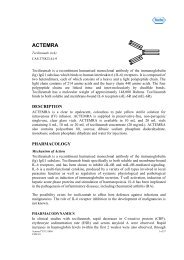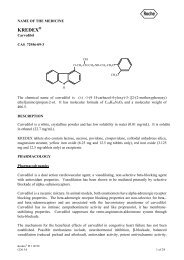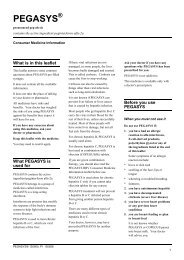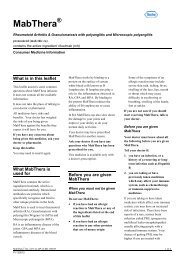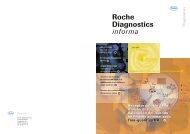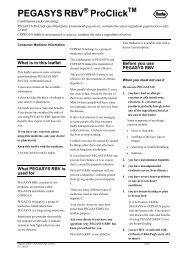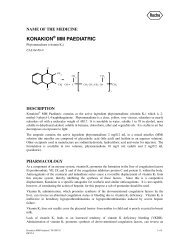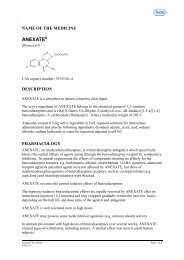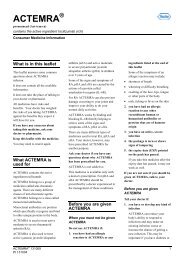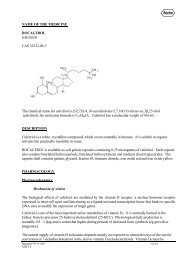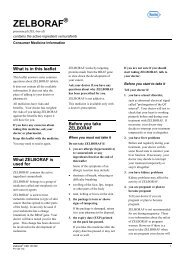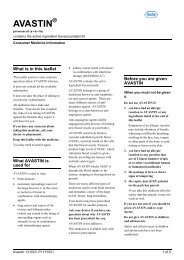Product Information PI - Roche Australia
Product Information PI - Roche Australia
Product Information PI - Roche Australia
You also want an ePaper? Increase the reach of your titles
YUMPU automatically turns print PDFs into web optimized ePapers that Google loves.
spontaneously within 1 – 2 days. In adult/adolescent prophylaxis studies, the most frequently<br />
reported ADRs were nausea, vomiting, headache and pain. In children, the most commonly<br />
reported ADR was vomiting. In the majority of patients, these events did not lead to<br />
discontinuation of TAMIFLU.<br />
Treatment and Prophylaxis of Influenza in Adults and Adolescents<br />
In adult/adolescent treatment and prophylaxis studies, ADRs that occurred the most<br />
frequently (≥ 1%) at the recommended dose (75 mg twice daily for 5 days for treatment and<br />
75 mg once daily for up to 6 weeks for prophylaxis), and whose incidence is at least 1%<br />
higher on TAMIFLU compared to placebo, are shown in Table 5.<br />
The population included in the influenza treatment studies comprised of otherwise healthy<br />
adults/adolescents and patients “at risk” (patients at higher risk of developing complications<br />
associated with influenza, e.g. elderly patients and patients with chronic cardiac or respiratory<br />
disease). In general, the safety profile in the patients “at risk” was qualitatively similar to that<br />
in otherwise healthy adults/adolescents.<br />
The safety profile reported in the subjects that received the recommended dose of TAMIFLU<br />
for prophylaxis (75 mg once daily for up to 6 weeks) was qualitatively similar to that seen in<br />
the treatment studies (see Table 6), despite a longer duration of dosing in the prophylaxis<br />
studies.<br />
Table 6:<br />
Percentage of patients with ADRs that occurred in ≥ 1% of the adults and<br />
adolescents in the oseltamivir group in studies investigating TAMIFLU for<br />
treatment or prophylaxis of influenza (difference to placebo ≥ 1%)<br />
System Organ Class<br />
Adverse Drug<br />
Reaction<br />
Treatment Studies<br />
TAMIFLU<br />
(75 mg twice<br />
daily)<br />
n = 2647<br />
Placebo<br />
n = 1977<br />
TAMIFLU<br />
(75 mg twice<br />
daily)<br />
n = 1945<br />
Prophylaxis<br />
Placebo<br />
n = 1588<br />
Frequency<br />
category a<br />
Gastrointestinal<br />
Disorders<br />
Nausea 10% 6% 8% 4% very common<br />
Vomiting 8% 3% 2% 1% common<br />
Neurological and<br />
Nervous<br />
System Disorders<br />
Headache 2% 1% 17% 16% very common<br />
General Disorders<br />
Pain < 1% < 1% 4% 3% common<br />
a<br />
Frequency category is reported only for the TAMIFLU group. Standard names to describe each of the<br />
frequency categories follow this convention: very common (≥1/10); common (≥1/100 to < 1/10).<br />
Adverse events reported in ≥ 1% of the adults and adolescents taking TAMIFLU in the<br />
treatment studies (n = 2647) and in the prophylaxis studies (n = 1945), which<br />
occurred more frequently in the patients on placebo or where the difference between the<br />
Tamiflu <strong>PI</strong> 6 mg/mL oral suspension and capsules 120119 16 of 28<br />
CDS 10.0



